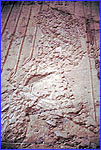
Despite the many months, if not years, workers took to carve Ramose's tomb out
of solid rock and begin illustrating its walls, the sepulcher was never
completed. Mid-way through its construction, Ramose suddenly left Thebes and
moved north to Tel el-Amarna, Akhenaten's new capital.
|  This
likeness of the "rebel" pharaoh Akhenaten on the outer wall of the Inner Hall
was defaced after he died, when Egypt promptly returned to its traditional
polytheism.
This
likeness of the "rebel" pharaoh Akhenaten on the outer wall of the Inner Hall
was defaced after he died, when Egypt promptly returned to its traditional
polytheism.
|
Your first view in the rough-hewn Inner Hall looks east, through a door into
the Main Hall and the sunny front entrance. On the floor of the Inner Hall, you
can see pedestals of the eight columns originally planned for this room; rubble
from the columns still litters the floor. Notice, too, the seemingly freshly
carved ceiling; in places, it looks as if stone masons might have chipped away
the white rock yesterday. In the rear (west) wall is a crudely carved doorway
to a small chamber, where inch-long chisel marks from the original carving out
of the crypt can still be seen on the roof.
 Ancient chisel
marks are clearly visible on the ceiling of the Inner Hall's side chamber.
Ancient chisel
marks are clearly visible on the ceiling of the Inner Hall's side chamber.
|
|
|
 |




 This
likeness of the "rebel" pharaoh Akhenaten on the outer wall of the Inner Hall
was defaced after he died, when Egypt promptly returned to its traditional
polytheism.
This
likeness of the "rebel" pharaoh Akhenaten on the outer wall of the Inner Hall
was defaced after he died, when Egypt promptly returned to its traditional
polytheism.
 Ancient chisel
marks are clearly visible on the ceiling of the Inner Hall's side chamber.
Ancient chisel
marks are clearly visible on the ceiling of the Inner Hall's side chamber.